In-Depth
A Brief History of VMworld
What started as a small gathering of virtualization geeks has grown into a powerhouse IT event.
If you hopped in a time machine and went back to the very first VMworld, you wouldn't have been bumping elbows with people on the escalators, or scrambling to find an empty chair for the opening keynote. In fact, the gathering would have felt downright cozy. Held in San Diego, Calif., the initial celebration of all things VMware had a grand total of 1,500 attendees.
Compare that with last year's show, which set a new attendance record at 23,000. The growth of VMworld has mirrored the growth of virtualization as an industry; what started as a way to run a different OS on a computer has become a multi-faceted force that now includes cloud computing, software-defined everything and itty-bitty containers that have taken over some of the functionality that used to be the domain of virtual machines alone.
Another example of the growth can be seen by walking the exhibit floor of VMworld. Bring comfortable shoes, because it can take hours to get nothing more than a cursory glance at every booth.
Suffice it to say that VMworld has changed a great deal over the years, and is now firmly entrenched as thego-to show for IT infrastructure, the one don't-miss event for those interested in the underpinnings of the modern datacenter. This year, as VMworld 2016 gets set to kick off for the 13th straight year, Virtualization Review thought it would be interesting to take a look back at previous shows, highlighting what made them interesting or memorable, including the personalities and products that highlight each show.
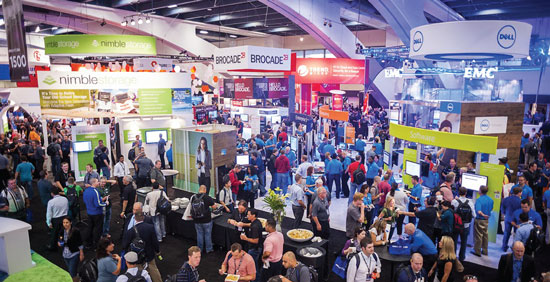 The VMworld show floor now has hundreds of vendors.
The VMworld show floor now has hundreds of vendors.
We'll start with the very first VMworld, and work our way up to the current day.
VMworld 2004
Location: San Diego, Calif.
Attendance: 1,500
VMware's theme for the first VMworld was "Join the Virtual Evolution." Keynote speakers included Diane Greene, company president and co-founder, along with her husband, Dr. Mendel Rosenblum, chief scientist and co-founder. Neither executive is with the company today.
The big VMware news was that the company was acquired by EMC Corp. in the same year. One Web site called VMware "an innovative small-time vendor largely unknown outside an enthusiastic circle of clients and datacenter professionals." Some core technologies of the time, like Virtual Center, vMotion and Virtual SMP, had been available for about a year.
EMC still owns VMware, of course; at least at the time of this writing. The huge acquisition that will bring it under the umbrella of Dell Inc. sometime this summer -- presuming that the deal is finalized and approved by all necessary entities -- is still in process.
It was also significantly cheaper to attend the first VMworld: $695 for early registration, $895 for regular registration and $1,195 for on-site registration.
VMworld 2005
Location: Las Vegas, Nev.
Attendance: 3,500
This was the first VMworld held in Las Vegas, where, incidentally, the show returns this year while its recent home in Moscone Center in San Francisco undergoes renovations. It didn't take long for word of the show to spread (along with interest in virtualization): attendance more than doubled from the previous year.
In her keynote address, Greene announced major new releases of its flagship datacenter products, VMware ESX Server 3 and VMware VirtualCenter 2; new services for server capacity planning and consolidation; and VMware Player, a "free new product that enables anyone to easily run, share or evaluate software in a virtual machine on a Windows or Linux PC." Greene, according to a VMware press release, "demonstrated how any PC running VMware Player can be used to read virtual machines."
The still-small company announced that "60 leading independent software vendors now support their software running on VMware virtual infrastructure."
The show also had a grand total of 51 sponsors.
VMworld 2006
Location: Los Angeles, Calif.
Attendance: 7,000
Once again, attendance for VMworld doubled, this time from 3,500 to 7,000. That's a pretty remarkable statistic; in two years, nearly four times as many people went to the show. That was surely a signal to VMware, and the rest of the tech world, that something big was brewing with this new-fangled "virtualization" stuff. According to one observer at the show, "The explicit message of this year has been: Software as a Service (SaaS)." The keynote was again given by Greene.
One of the big announcements at the show was the Virtual Appliance Marketplace and Certification Program, a storefront and certification program for virtual appliances. It kicked off with about 300 appliances available. Another unveiling was the VMware Lab Manager, the result of a recent acquisition of Akimbi Systems. In terms of competition, Microsoft announced its "VHD Test Drive" program. These pre-configured virtual hard drives allowed customers to test Microsoft enterprise software in a safe environment.
The number of vendors coming to the event was growing, as well; one media report said that at least 80 vendors were there.
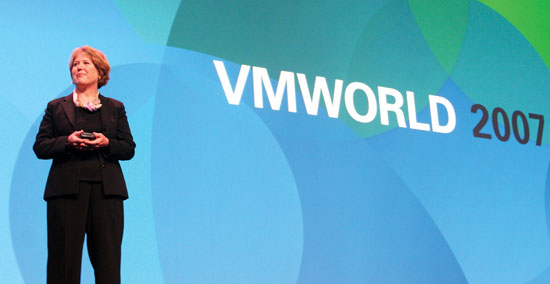 VMware's first CEO, Diane Greene.
VMware's first CEO, Diane Greene.
VMworld 2007
Location: San Francisco, Calif.
Attendance: 10,800
This was the first VMworld to be held in San Francisco. Attendance didn't double, as for the previous shows, but still showed healthy growth at 10,800. CEO Diane Greene laid out the current state of the industry in her opening keynote: "A year ago, we were talking about virtualization becoming mainstream. Now, we are talking about a virtualization industry. It's an incredible time to be part of it... Virtualization is driving a complete infrastructure refresh. The datacenter is getting modernized and getting optimized, as well as all the infrastructure products; the virtualization layer is offering a better way to handle disaster recovery, security, provisioning and more and we're helping companies use less power."
The fourth VMworld also saw the introduction of ESX Server 3i (ESXi), which became a crucial product for VMware. It was fending off challenges from Microsoft and especially Citrix, which released XenExpress on the eve of VMworld 2007 to compete directly with ESXi. Citrix faded, and Microsoft eventually took sole possession of second place in the virtualization industry, a spot it still holds.
Two other core products were released by VMware at the show: Virtual Desktop Manager, a virtual desktop infrastructure (VDI) connection broker, and Site Recovery Manager, for disaster recovery scenarios.
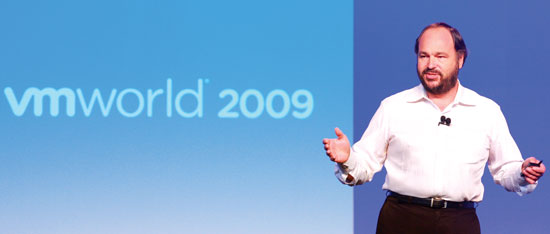 Paul Maritz took over as CEO in 2008.
Paul Maritz took over as CEO in 2008.
VMworld 2008
Location: Las Vegas, Nev.
Attendance: 14,000
Diane Greene was no longer with VMware by the time VMworld 2008 rolled around, having been fired by the Board of Directors in July of that year. The new CEO was veteran Microsoft executive Paul Maritz. Maritz, to his credit, started his keynote with a history of VMware, which Greene and Rosenblum founded 10 years previously. (Greene now heads up the growing Google Inc. cloud business.)
Maritz discussed the three pillars he wanted his new company to focus on going forward: the cloud, VDI and datacenter virtualization. The datacenter product was the Virtual Data Center OS, or VDC-OS. The others were vCloud and vClient. vCloud, which morphed several times over the years, had more than 100 partners at the beginning.
One other important note from Maritz's VMworld debut: It was the first time VMware made it obvious that it would need to eventually transition away from relying on the hypervisor as its core business.
VMworld 2009
Location: San Francisco,Calif.
Attendance: 12,500
VMworld 2009 was the first (and only) VMworld to see a drop in attendance. About 1,500 fewer people came out, which some blamed on the tanking economy. Prices for the show ranged from an early-bird price of $1,495 to an on-site rate of $1,895.
VMware said at the show that only 30 companies in the Fortune 1000 didn't use VMware; that speaks to the enormous growth of its signature hypervisor. This show was Paul Maritz's second as CEO, and he talked up the recently introduced product that became VMware's most important ever: vSphere. Formerly known as VMware Infrastructure, Maritz said during his keynote that with upgrades, "There is now literally no application that cannot be considered a candidate for virtualization."
Maritz also said, according to one blogger, that vSphere was a bigger release than any Windows release on which he worked while at Microsoft.
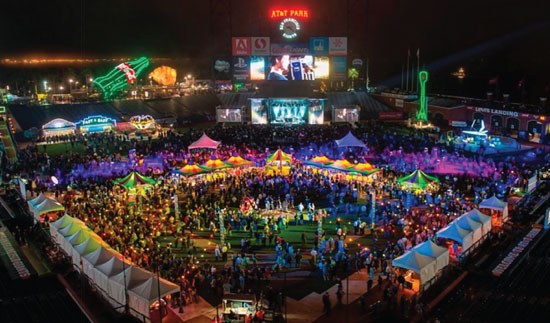 VMworld is justifiably famous for its big annual party.
VMworld is justifiably famous for its big annual party.
VMworld 2010
Location: San Francisco, Calif.
Attendance: 17,000
Attendance recovered in a big way in 2010. The record number of attendees heard about VMware's direction into the cloud: The focus was on IT as a Service and the hybrid cloud model. The big product announcements were centered around this idea. They included vCloud Director, for delivering and consuming IT services across hybrid clouds; vShield, a product family to tackle cloud security challenges; and vCloud Datacenter Services, designed to help customers build secure, interoperable enterprise-class clouds delivered by services providers.
On the desktop side of things, VMware announced VMware View 4.5. Chris Wolf, then an analyst with Gartner Inc. (now a VMware CTO), was impressed. He wrote: "The View 4.5 Premier release represents a significant milestone as it places VMware in very select company with Citrix as the only two vendors that offer enterprise-ready server-hosted virtual desktop (SHVD) solutions." In 2016, the situation is similar in that VMware and Citrix are still the leading VDI vendors in the industry.
233 sponsors and exhibitors showed up, again representing the expansion of virtualization as a central pillar of IT.
VMworld 2011
Location: Las Vegas, Nev.
Attendance: 19,000
"Own It. Your Cloud." That was the VMware slogan for its 2011 show in Las Vegas. VMware touted cloud computing as the future (which was correct), and said that it was uniquely positioned to provide it (a less successful prediction). One of its big product announcements was vCloud Connector 1.5, created to view, transfer and manage workloads between vSphere clusters and private and public clouds. It also launched a Web site -- vcloud.vmware.com -- to connect customers with cloud providers and test-drive cloud services.
However, the "all cloud, all the time" focus left some attendees wondering if VMware was veering too far off of the virtualization path. For example, longtime VMware watcher and reporter David Marshall, questioned the new priorities: "The company also said that VMworld 2011 is ‘specifically designed for IT professionals seeking to accelerate success in their enterprises as they preserve existing investments while aligning their specific requirements to enable the cloud.' There's that ‘C' word again, and no mention of the ‘V' word."
VMworld 2012
Location: San Francisco, Calif.
Attendance: 21,000
The passing, again, of the CEO torch marked the highlight of VMworld 2012. Paul Maritz was out, and Pat Gelsinger, the current CEO, was in. Here's how it was reported in Virtualization Review:
"‘I'm happy to be formally turning over custodianship of this community to Pat Gelsinger,' Maritz told the crowd as his successor took the stage. ‘Nobody can accuse Pat of being laid back.'
‘Take good care of her,' Maritz said as he shook Gelsinger's hand and left the stage."
During his keynote, Maritz noted that 60 percent of workloads were now virtualized, meaning that, in his words, virtualization has become "... the default way for organizations to deploy servers." That number has steadily increased over time, and now stands at about 75 percent.
The other main focus, beyond the Maritz-to-Gelsinger handoff, was a new buzzword that has since become a major direction for VMware: the "software-defined datacenter," or SDDC. Virtualizing additional aspects of datacenter operations like networking and storage would lead to greater efficiencies, VMware claimed. It's been a solid play for VMware, which has taken the industry lead in this area.
A side note on a decision that helped quell an uproar: One of Gelsinger's first acts as CEO, announced at this show, was to kill the "memory tax." This fee was based on the amount of virtual memory (VRAM) used by vSphere, and immediately reviled by the community. VMware got the message quickly and dropped the hated tax.
VMworld 2013
Location: San Francisco, Calif.
Attendance: 22,500
This show marked 10 years of VMworld. From not much more than a curiosity in 2004, with its 1,500 attendees, the show had become a monster, straining even the expansive Moscone Center's capacity.
There were plenty of big unveilings at the show, including two products that have continued to grow in importance (in contrast to the cloud offerings from past years, which have faded some): NSX and Virtual SAN, or VSAN. NSX is VMware's software-defined networking (SDN) technology, and has become a central part of the company's SDDC vision, including hyper-converged infrastructure (HCI) appliances. VSAN is software-defined storage (SDS) that creates pools of storage for virtual machines. Both VSAN and NSX are underpinnings of SDDC.
The other big release was vSphere 5.5. Although a point upgrade, it felt more like a major upgrade, with a host of new features, including doubled performance, along with better scaling. It became the standard version of vSphere for many shops, and remains that way for many businesses today, even though vSphere 6.0 has been out for some time.
VMworld 2014
Location: San Francisco, Calif.
Attendance: 22,000
Spending its third straight year at the Moscone Center, the attendance figures leveled off, as the numbers didn't changed much since 2012. The theme of the 2014 show was "No Limits," which for VMware basically meant running any application, on any device, anywhere -- using VMware products to make it all happen, of course.
Some of the keynote announcements were more in the nature of re-branding. vCloud Hybrid Service, for example, was renamed vCloud Air; but the name change didn't help the product much. Another rebranding effort was the "vRealize" family of offerings, which offered a range of products for managing SDDC and cloud environments.
Two other products of note that VMware announced at the show: EVO:RAIL, a hyper-converged appliance given a great deal of fanfare; and VMware Integrated OpenStack, which allows companies to use the popular open source cloud technology to build private clouds on top of vSphere.
EVO:RAIL didn't fare well in the market, and has been dropped. As The Register reported, "It's not been formally cancelled, but links to it are disappearing from vmware.com and VSAN will take over the mantle as VMware's hyperconverged champion."
As for Integrated OpenStack, those numbers are hard to come by. But OpenStack by itself is doing very well in the market, having become the de facto solution for building private clouds.
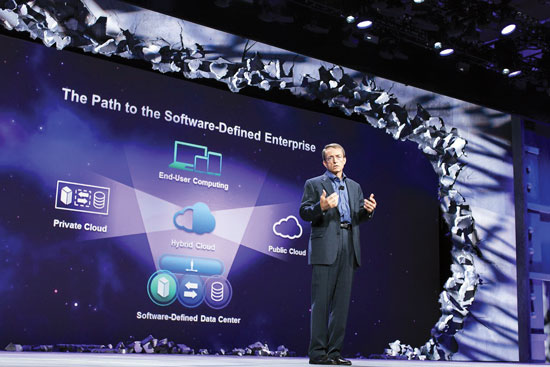 Current CEO Pat Gelsinger faces big challenges at this year's VMworld.
Current CEO Pat Gelsinger faces big challenges at this year's VMworld.
VMworld 2015
Location: San Francisco, Calif.
Attendance: 23,000
VMware said last year's show broke the attendance record (again), but it wasn't by much. Still, 23,000 attendees is no small number, and shows the strength of both VMware's brand and the virtualization industry in general.
During the keynote, VMware demonstrated its awareness of the technology that could be a big threat to its dominance: containers. Containers are lightweight ways to package up apps, making them highly scalable for the cloud, and allow for great density on a server. For cloud-based computing, they compete directly with virtual machines, with significant advantages (and some drawbacks, as well).
In response, VMware decided it was better to hop on board that train, rather than pretend that containers didn't exist. Hence, the announcement of vSphere Integrated Containers, which run on the vSphere framework.
VMworld 2016
Location: Las Vegas, Nev.
Attendance: ???
This article is being written before the 2016 show. But it's easy to predict that one topic will dominate conversation among attendees, even if it won't be a VMware focus: What's going to happen once Dell is the new sheriff in town? How hands-on will Dell be? Will changes be forced onto VMware, or will the company, as it was under EMC's rule, be allowed to run its business the way it wants?
So there you have it: 12 years (and counting) of VMworlds. It's fascinating to see the changes in VMware and how they're reflected in its premier event. Some of the products introduced to the world at the shows were flops; others were huge hits. VMworld has also mirrored the changes in virtualization as an industry, and its own growth from a small, niche technology that few took notice of, to an encompassing force that literally changed the face of IT in ways no one could have predicted back when 1,500 geeks gathered in San Diego for VMworld 2004.